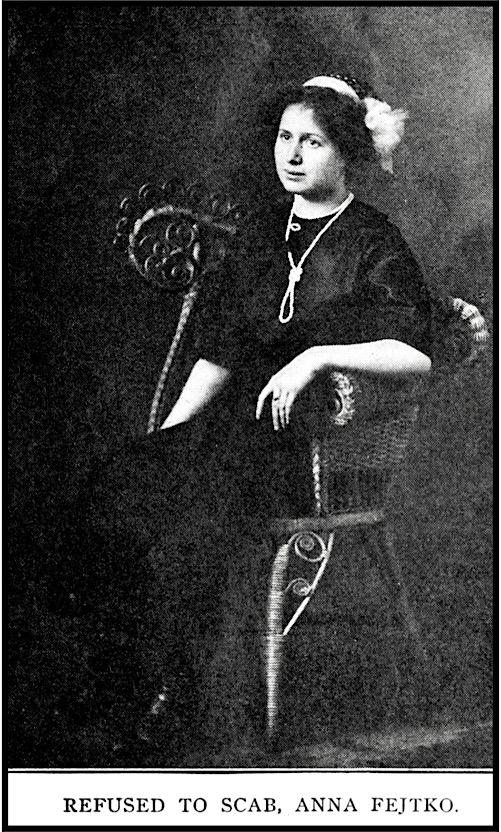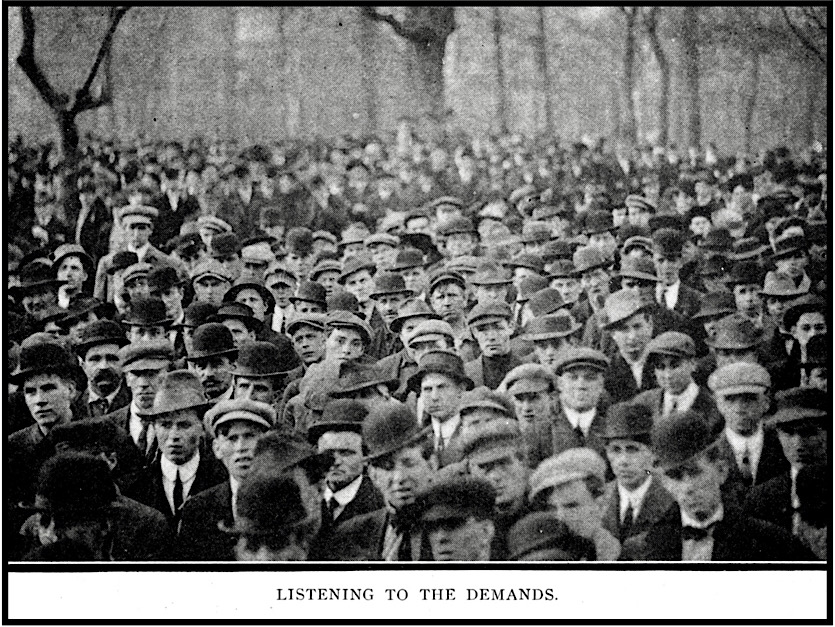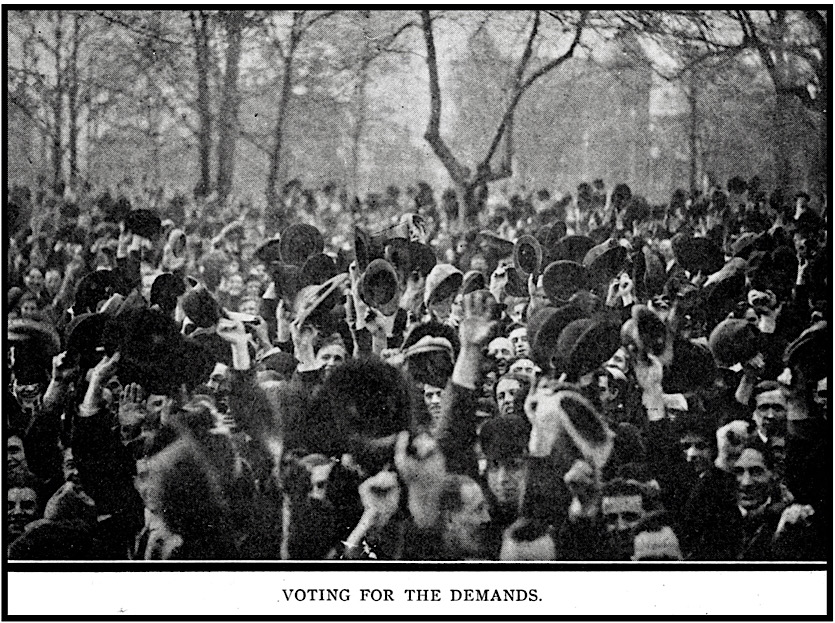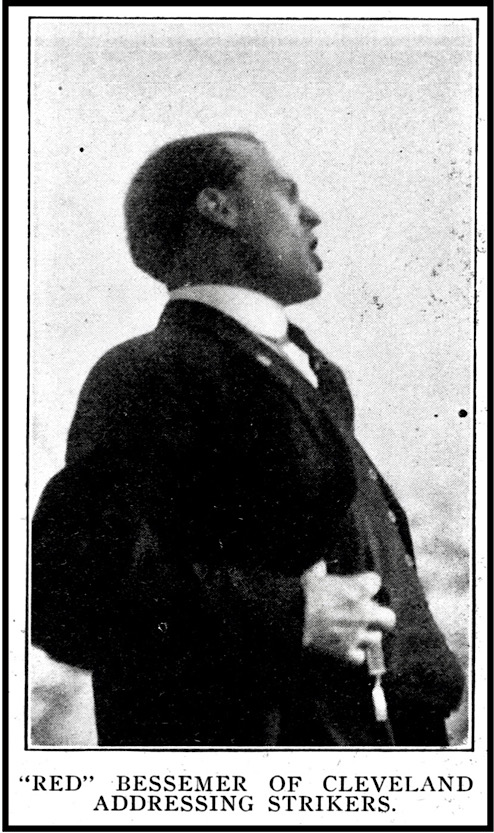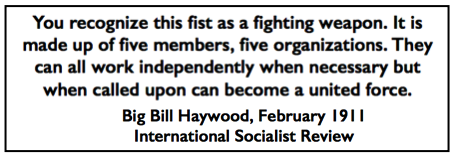 —————
—————
Hellraisers Journal – Friday April 18, 1913
Akron, Ohio – The Story of Annie Fejtko, Goodrich Striker
From the International Socialist Review of April 1913:
800 Per Cent and the Akron Strike
By Leslie H. Marcy
[Part III of IV]
The following story printed by the Akron Press, a paper which has tried to give the strikers’ side some showing in this bitter struggle, is the general answer of the women and girls who joined the strike:
Annie Fejtko, eighteen, joined the Akron rubber strikers Friday. She’s all alone in Akron-her own provider, housekeeper, washerwoman-and a mere child.
This is Annie Fejtko’s own summary of what she pays and how she spends it:
Average weekly pay, $4 to $4.50.
Weekly board bill, $3.
Left for dress, amusements, etc., $1 to $1.50.She came to Akron about a year ago and has been working for the B. F. Goodrich Company ever since. She started to work on 10-hour day work, for $1, a day.
“I only worked that way three weeks,” said Annie. “Then they put me on piece work. My average two weeks’ pay is $8 or $9. I can’t save anything and I haven’t seen papa or mamma or the little brothers and sisters since I came here.
“They only live in Pennsylvania, too, but I can’t save enough to go and see them.”
The last day Annie worked she made 75 cents. Lots of days she said she made less.
“Some days I can make $1.25 and once in a while $1.50, but that’s only when I work on certain kinds of work, and just as fast as I can all day, without resting.”
The highest Annie has ever been paid for a day’s work, was $2. She never made that much again, she says. That day she was cutting paper rings to hold the rubber bulbs in packing. When Annie went home that night her hands were blistered from the scissors.
For some time before the strike Annie had been working in what is known as department 17-B, of the Goodrich. This is the rubber bulb branch. Her work is constantly changed, but for the most of the time she has been inspecting the hard rubber stems for the bulbs, she said. She is paid 9 mills a hundred for this work and makes around $1 when kept doing this all day.
But there’s stamping of time cards to be done, and the work is passed around. “Two mills a hundred is paid for this work,” says Annie, “and if you don’t work all day you couldn’t make over 25 cents.”
“In some of the departments the girls make more,” Annie states. “The buffers (a line of rubber bulb work), make as high as $2 a day when they get to work all the time, but lots of times there isn’t enough to keep them busy. Sometimes they are sent home and other times they stay around all day expecting more to do and only get about 25 cents worth of work.
“But I can’t make that much,” the girl says. “I suppose I’m not fast enough or something. But I work hard, ten hours every day and I have to do my own washing in the evenings, and skimp awful.”
When the strike started Annie didn’t quit. It ran from Tuesday until Friday. She wanted more money for her work, but she didn’t have anything saved and thought she couldn’t afford to lose a day.
“Friday Charlie, one of the pickets talked to me at noon. I decided I couldn’t be much worse off so I laid down my tools and four other girls in that department followed me out,” she explained.
“I haven’t any money and I have to pay board and-” she looked seriously out of the window, “but I suppose they’ll help me.”
“If I don’t get any more, though, when I go back, I don’t see how I can ever catch up out at Santo’s where I board.”
The general demands of the strikers may be briefly summarized as follows:
Universal 8-hour day.
Abolition of piece work.
Abolition of Taylor speeding-up system.
Time and one-half for overtime.
A general 25 per cent increase to the lowest and a 20 per cent increase to the highest paid workers.
One feature of the strike that was unexpected by the factory owners was the senatorial probe instigated by Comrade Margaret Prevey, and introduced in the state senate by Senator Wm. Green.
Comrade Allan Cooke ably represented the strikers in this probe. His questions gave proof to the public that the factory owners had put through some very mysterious deals in the way of what looks extremely like DROWNED (instead of “watered”) stock; also that unheard-of dividends had been declared even upon these inflated issues. He also brought out the real conditions of the rubber workers.
The following is the report of one of the strikers showing that the harder he worked to keep his earnings up to the old schedule, the lower his wages seemed to go under the speeding-up process.
Last summer Leonard Gowin, forty-seven, father of 13 children and a stuffer of hard tires in the Diamond plant of the ninety-million-dollar B. F. Goodrich Company, was earning about $4 a day.
Through the winter, when there have been added coal bills, heavy clothes, school books and other things to buy, he has been paid only about $2.50 a day and sometimes as low as $2, he says.
Gowin is a typical victim of the speeding-up, piece-work system which has led directly to the present rubber strike.
It isn’t because Gowin works shorter hours. It’s been a 10-hour day ever since he started. “I’ve worked lots harder this winter,” he adds, “but I can’t make as much. And I tell you when a fellow has as many little tots as I have, he needs every cent he can get.”
Gowin has bought a little lot out at Shop 97 on the Barberton line. Working evenings last summer and on Sundays, he made the cement blocks, bought lumber and lone-handed built a home. He had visions of a cozy winter.
“My wife and I talked it all out,” he said. “But it hasn’t worked out very well. Seems like the pay gets less all the time, under the piece work system.”
One of Gowin’s daughters, a girl in her teens, has gone to work. She’d have liked finishing school, but there were a half dozen little tots to clothe and buy medicine and milk for.
Less than six months ago, the children had nice clothes for Sunday school. Now the dresses and little suits are bought for wear.
“Back under the day work system men made $4 to $7 for skilled labor,” said Gowin. “But this piece-work speeding has hit them all about like me-only most of them haven’t so many children.
“This strike hits me pretty hard. I’m not complaining, you understand. I went out on my own hook, even if I did stick till Monday because I thought I couldn’t spare the money.
“I hope it comes out right for us. If it’s the same when we go back, I think I’ll have to sort of start life over again-working at something else.
“It’s pretty late, when a fellow gets nearly fifty, but the pays keep shrinking and the children grow bigger and more expensive, and I guess it’s the only way.”
The strikers early opened a soup kitchen and the way the workers elsewhere are responding now show that they do not mean to have any of their comrades suffer. Several hundred rubber workers walked out in Cleveland and the bosses of the scab factories in Detroit are wringing their hands and “laying off” men because automobiles without tires are about as useful as snow shoes on the sea.
One night early in March a stranger to Akron dropped off an evening train. He saw the groups of men gathered about the city and asked if there was some kind of a celebration going on. “Nope,” said one of the ex-rubber workers-“only a strike.” “Well, well,” the stranger said, “and I came here to get a job in one of the factories. I guess I’ll be beating it. I’m not so yellow that I have to scab, even if I AM broke.“
[Emphasis added.]
~~~~~~~~~~~~~~~~~~~~~~~~~
SOURCES & IMAGES
Quote BBH One Fist, ISR p458, Feb 1911
https://play.google.com/books/reader?id=8-05AQAAMAAJ&printsec=frontcover&pg=GBS.PA458
International Socialist Review
(Chicago, Illinois)
-Apr 1913, pages 719-722
https://www.marxists.org/history/usa/pubs/isr/v13n10-apr-1913-ISR-riaz-ocr.pdf
See also:
American Rubber Workers & Organized Labor, 1900-1941
-by Daniel Nelson
Princeton University Press, Jul 14, 2014
(search: with last names mentioned above)
https://books.google.com/books?id=LAMABAAAQBAJ
James P. Cannon and the Origins of the American Revolutionary Left, 1890-1928
-by Bryan D. Palmer
University of Illinois Press, Oct 1, 2010
(search: with names mentioned above)
https://books.google.com/books?id=3m_97zuy6_MC
Tag: Akron Rubber Workers Strike of 1913
https://weneverforget.org/tag/akron-rubber-workers-strike-of-1913/
~~~~~~~~~~~~~~~~~~~~~~~~~
What We Want – John McCutcheon
Lyrics by Joe Hill

